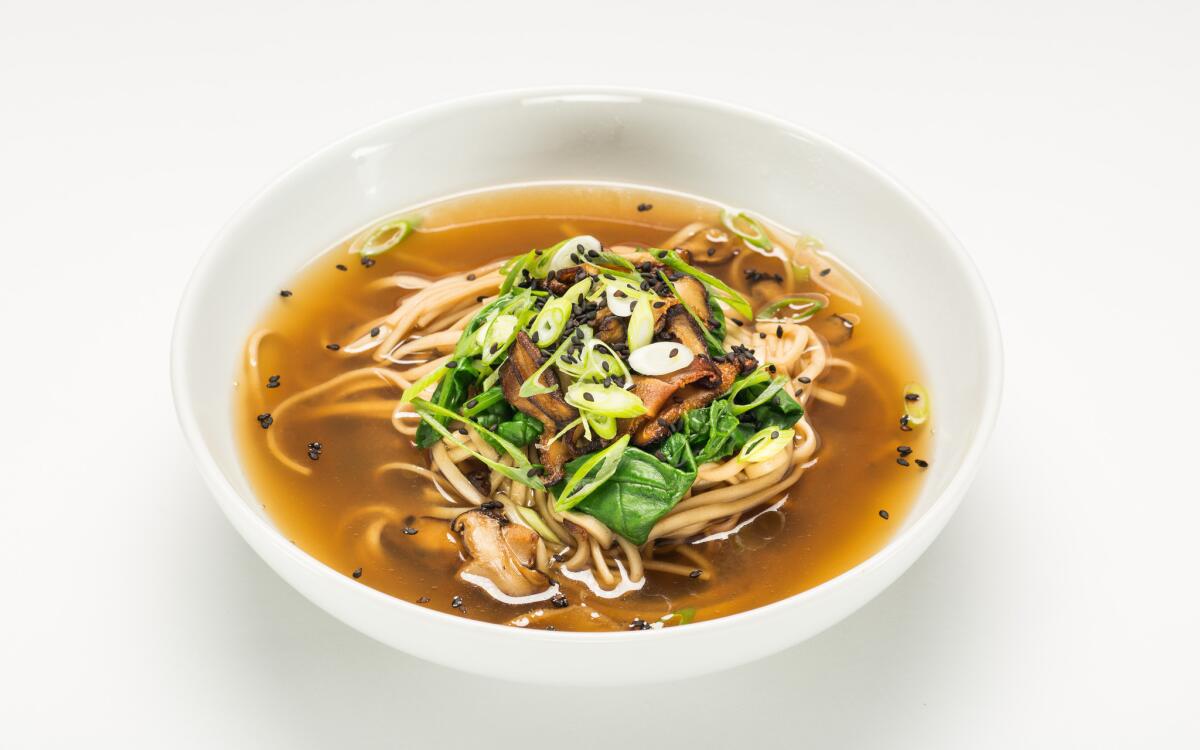Udon with tea broth

The next time you sit down for a cup of tea, take in the aromatic steam while it’s brewing. The smoky flavor of hojicha, a drink made from green tea that’s been smoked over charcoal, might suggest the aroma of a woodsy campfire. Genmaicha, which combines grassy green tea with crisped and popped brown rice, is simultaneously lush and earthy. Assam can be as malty and rich as chocolate.
All of which is a reminder that you can do a lot more with tea than drink it. Tea is a fantastic culinary ingredient, adding depth and complexity to food without adding fat or dairy or other animal products.
Because the cultivation of tea stretches back thousands of years, cultures have been experimenting with different uses for the leaves for just as long. (The Chinese have been tea-smoking ducks and cooking eggs in tea for centuries.) Not only has tea been ritualized, it’s found its way into a wide variety of cooking methods.
You can use tea in both cold and hot smoking, you can steep liquids with tea — not only water, but also dairy, oils and vinegars — and use it as part of spice rubs. (It’s great with just salt and pepper as a crust for salmon.) You can grind or chop tea and stir it into doughs and batters, use it as a poaching liquid or in making broths — or even use it in place of broths in recipes.
Robert Wemischner, a longtime pastry chef and cooking instructor, is the author of “Cooking With Tea,” which was published 15 years ago, long before the current wave of tea-infused panna cottas started appearing on menus around town. Wemischner’s favorite tea at the moment is probably keemun, a black tea from northern China, which, he says, works particularly well when added to seafood dishes. And don’t forget braising in tea — brisket, he says, is fantastic when made with tea.
Kuniko Yagi, formerly executive chef at Hinoki & the Bird and before that at Sona, says that her favorite tea is hojicha. She grew up drinking it, even as a baby (it has very little caffeine), in Japan. Now she makes peaches en papillote with the tea, serving them with whipped cream that she also flavors with hojicha. She’ll infuse the tea in a crème brûlée custard and fold it into the batter of a chiffon cake. She also makes glorious simple shortbread cookies by stirring crushed tea leaves into a dough made with brown rice flour.
If all this sounds a bit complicated — especially if you’re used to just throwing your tea into a pot of hot water — then maybe try making rice with your favorite tea. Just brew a few cups of tea, cool it and use it instead of water in a rice cooker. (One particularly great combination is genmaicha and Japanese short-grain brown rice.) The results are subtle and kind of miraculous, the rice even nuttier and more floral and earthy than before.
Or try cooking udon noodles in tea, a pine-smoked black tea for example. Then add some vegetables and a splash of soy sauce or sesame oil and serve. The results are aromatic, soothing — and vegan. And if that’s way too healthful for you, you can make those shortbread cookies for dessert.
::
The simple secrets to making tea
One thing to watch out for, if you’re cooking with tea or just making yourself a cup, is to not boil the tea or use water that’s too hot (or impure), and also be careful when you steep it. For every tea, and there are thousands of them, there’s a different method of brewing that will bring out the best of the leaves. How to determine this? Just taste the tea as it steeps and strain it before it gets bitter. And although tea accouterments are pretty swank, all you really need to make a good cup is a palate, a bit of patience and a basic strainer.
Bring 6 cups of water to a boil, remove from heat and cool slightly. Add the tea, konbu and ginger, and set aside to steep for 10 minutes.
Meanwhile, sauté the mushrooms in the sesame oil until golden brown, then remove from heat and hold in a warm place.
Strain the broth into a small pot. Add the udon to the broth and bring to a boil. When the noodles froth up, add a cup of cold water. When the water returns to a boil, reduce the heat to a gentle simmer until the noodles are cooked.
Divide the cooked noodles between two bowls. Briefly blanch the spinach in the hot broth, then strain. Add a few cups of broth to each bowl, then top with the mushrooms, spinach and scallions. Drizzle with soy sauce as desired and garnish with sesame seeds. Serve immediately.
Get our Cooking newsletter.
Your roundup of inspiring recipes and kitchen tricks.
You may occasionally receive promotional content from the Los Angeles Times.
















